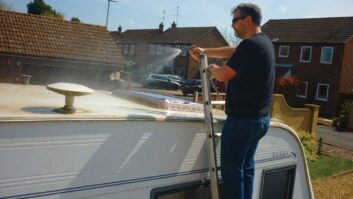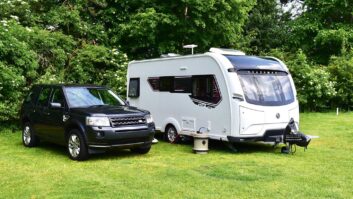READER RICHARD MINNS has one of the most popular and useful mod cons installed in his caravan – an automatic dishwasher.
Previously fitted to his 2002 Fleetwood Heritage 640CB, Richard made sure his current van, a Geist Xklusiv 635, could accommodate the unit before he bought it. As both caravans are twin axle models with sufficient payload, and importantly have a large enough kitchen cupboard to accommodate the machine, this wasn’t a problem.
Here’s Richard’s account of the work involved to fit a dishwasher in a caravan:
Ascertain that sufficient depth and clearances exist in a suitable cupboard – check for existing pipework and wiring runs. It is necessary to provide a shelf at the required height within the cupboard – in both cases I simply removed the existing fittings and lowered the existing shelf. When reinstalling I added additional strengtheners to the shelf including block-legs to the floor, to take the weight of the machine. You may need to move other obstructions or re-route utilities. Double check that the cupboard door will close once the machine is in situ (check for extrusions on the machine itself too ie protruding controls etc, and allow space).
The Fleetwood had a pressurised water system which simply necessitated the branching of a spur to the appliance from the cold water pipe running through the cupboard, the water supply being provided by a submersible hi-flow pump in an external Aquaroll.
Inboard water tank
The Geist has a microswitched water system, and also an inboard water tank. For this van I have laid an additional cold supply pipe from the tank direct to the dishwasher inlet, fitting an in-line 12V pressure switch on this supply, and a standard submersible hi-flow pump attached to this line permanently installed in the inboard tank.
It is necessary to provide a connection terminating with a domestic screw fit for the appliance – this can be achieved by utilising an appliance extension pipe (easily available) and cutting off one end to fit a straight connector on the spur from the van’s water line – secure with jubilee clip. The connection to the machine can be made using a screw-fit connector.
It is important to also fit an isolating stopcock in the water supply to isolate the appliance when needed, and also if a separate water pump serves only the appliance, a 12V isolation switch should be fitted to enable isolation of the pump 12v supply.
Waste outlet required
A waste outlet will be required, and can be provided either by a Y-connector to a suitable existing waste pipe in the cupboard, or provide a secondary outlet dropping through the floor and terminating at a standard outlet adjacent to existing pipework. The waste outlet from the appliance will ideally feed into a stand-pipe arrangement, again for ease of removal when required. Ensure the waste outlet has sufficient vertical drop to accommodate the inserted discharge hose, and that the outlet pipe will cope with the fairly high discharge rate of hot water.
A 240V supply will need to be provided for the appliance. Either utilise an existing socket if a suitable one exists in a convenient location, or install an additional socket in a suitably convenient position within the cupboard or in adjacent units.
Compact domestic model is ideal
The appliance I have used is a Zanussi DCS12W, which is a compact domestic model designed to accommodate 4-5 place settings. Any compact domestic model should be suitable – the biggest issue is the physical dimensions and the weight. This model is not designed specifically for caravans, but is a small machine for worktop or cupboard. This particular machine has adjustable feet with a screw fitting – this provided an ideal securing opportunity as I inserted screws through the mounting shelf into the underside of the two front feet of the machine. It is important to have a secure retaining arrangement for any appliance to prevent damage during travel.
I can confirm that the machine operates perfectly – exactly as in a home environment. When a dishwasher (or washing machine) is switched on, an inlet valve on the machine is automatically opened to enable the appliance to fill – this would be direct from a mains supply at home, but in a caravan supply as the appliance valve is opened, the caravan pressure switch automatically activates as it detects a pressure drop, and the machine will fill. The standard submersible or in-line hi-flow pumps commonly used in caravans will provide sufficient pressure to fill the machine.
Electrical requirements
This machine has a maximum electrical load of 1280W when heating the water, 1200W for the heating element and 80W for the circulatory and discharge pumps. This requirement can be easily accommodated within a caravan’s electrical system – as with all appliances it may be necessary to not run everything at once to avoid any tripping out of the site supply if a low amperage is provided at the bollard.
I have not had any problems, even on Continental sites where the supply is often famously lower than in the UK. The machine has a variety of programmes but a standard hot wash and three rinses/drying uses 12 litres of water, and completes in around 45 minutes. My inboard tank holds 70 litres, and a standard Aquaroll holds 40 litres, so the water requirement is easily met.
Payload allowance needed
The machine weighs approximately 23kg, so allowance must exist in the van payload. Generally caravan kitchens are over the axle, which is ideal for a heavy appliance. If the kitchen is not over the axle, then check the effect on nose or tail weight.
Also ensure that any pipework runs to the machine will drain out when needed during any winter lay-ups; if necessary fit an additional drain cock in the pipework to protect any in-line pressure switch, and to ensure ice pressure can’t develop at the inlet valve on the machine. I have not had any problems with the machine during winter lay-ups – always ensure (as for the fridge) that the appliance is thoroughly cleaned, including the filters, and left slightly open. The hot operating temperature of the machine when in use sanitises very well.
The verdict
I have enjoyed the luxury of a fitted dishwasher in my caravan for several years now – this machine has travelled many thousands of miles both in the UK and in many European countries and has operated perfectly. I can vouch for its usability and durability; I certainly wouldn’t be without it – hence when I changed my caravan at the very top of my shopping list was a suitable kitchen to reinstate this most appreciated of mobile conveniences…







